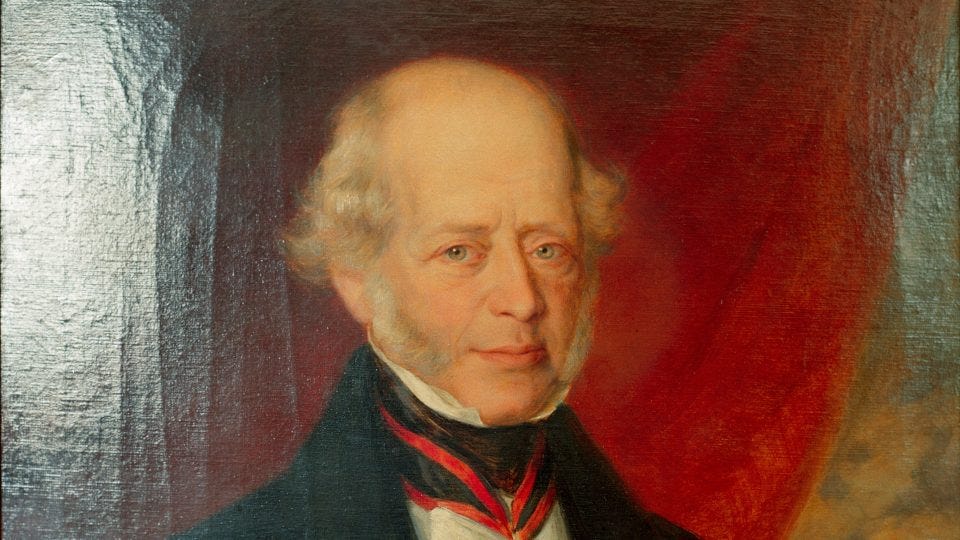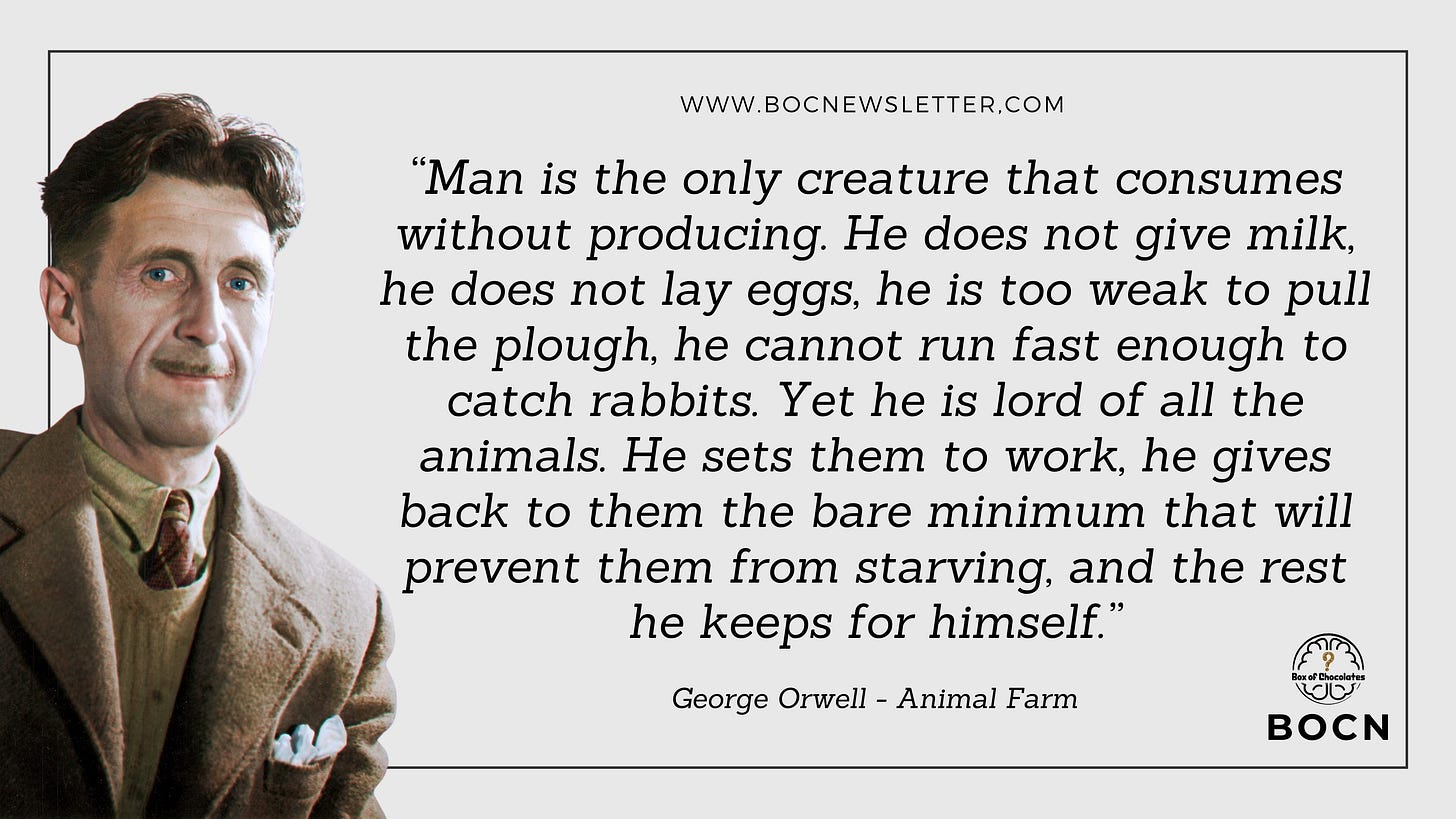Mayer Rothschild: How To Build A Bank
Mona Lisa, On This Day, Photo of the Week, & Animal Farm.
BOC#033
7 MINUTE MUNCH
TITLE PIECE: HOW MAYER ROTHSCHILD BUILT THE MOST POWERFUL BANK IN THE WORLD
Mayer Amschel Rothschild was born in the eighteenth-century German ghetto of Judengasse in Frankfurt in 1744. One of ten surviving children, Mayer’s father traded coins and silk in order to fund their dingy nine hundred square foot home overlooking a narrow ghetto alley.
The ghetto’s streets were so narrow that horse-drawn-wagons had difficulty turning around, and Mayer often walked down the street’s center in order to avoid the raw sewage that flowed down the sides. While Mayer would receive a typical elementary Judengasse education in Jewish scripture, literature and tradition hosted by the local synagogue, he would eventually go on to shatter ghetto expectations by founding and building one of the most powerful financial institutions in the world.
Frankfurt was a key port on the river Main which flowed into the Rhine, and was under the auspices of the Holy Roman Empire. The Vienna ruled city hosted semiannual trade fairs which connected traders, bankers, princes and dukes from far-off lands.
When Mayer’s parents died of smallpox while he was still only twelve, he was sent to become an apprentice with Wolf Oppenheimer, a prominent Hanoverian Jewish banking house where Mayer’s father likely had connections. It was here the Mayer learned about the rare historic coins of Rome, Persia and Byzantium. During his time at Wolf Oppenheimer, the young Rothschild made acquaintances with an array of wealthy princes and collectors, and was prepared for life as a Court Jew.
A Court Jew was an honourable post whereby a Jew would advise and counsel powerful men on financial affairs, often calling on family connections in the Jewish Diaspora across Europe and the Muslim world. They became prominent players in the management of state finances raising funds for armies and navies.
By the time Mayer was twenty, he set up his own business trading rare coins, medals, stones, and antiques, bringing him into contact with the wealthy elite. His prestige eventually escalated seeing him take on the role of occasional trading agent for Prince William, son of King Frederick II of Hesse-Kassel. Rothschild later convinced William to make him the court agent which would give him increased influence and clout in royal circles. At twenty-six, Mayer married Gutle Schnapper who would bear him nineteen children, ten of whom survived. Of these ten, five would go on the found the future House of Rothschild.
Mayer worked his way into the financial mechanisms that saw Prince William rent conscripts to the British during the American Revolution. Having persuaded treasury star Carl Friedrich Bederus to lobby William on his behalf, Mayer gained a role in redeeming British notes on William’s behalf. With no branches outside England, British notes had to be redeemed at British banks. The middlemen who redeemed the notes, exchanging them for German currencies, made a profit on the spread. Mayer monopolised this role, squeezing his rivals by accepting smaller profits. When William succeeded his father as king, Mayer looked to Carl Friedrich Bederus for greater influence.
Mayer’s exploits didn’t end here. He became a merchant of English wools, cottons, coffee and sugar, to the extent that he bypassed English middlemen by sending his son Nathan to establish an in-house Rothschild operation that oversaw the transportation of textiles from Manchester directly to the family’s operations in Frankfurt. Nathan caught the attention of Levy Barent Cohen, one of England’s richest Jews, marrying his daughter in 1806. This saw his wealth skyrocket (tripling his capital in three years) and aided the building of valuable diplomatic ties.
In light of the European wars and diplomatic struggles to redraw borders, Rothschild saw ample opportunity to help governments raise money for armies, refinance war debts, and manage trade embargoes. He and his five sons began employing financial strategy to world politics which extended much beyond his original Prussian client, William. The Rothschilds were becoming masters at playing all sides.
With French armies approaching, Rothschild helped fund the defence of his hometown of Frankfurt in 1792, and when Prince William opted to support England against France for a subsidy of £100,000, it was Mayer who bought the British IOUs.
With William forced to flee Hesse-Kassel, and fearing for the abandoned fortunes of William, the Rothschilds had a degree of control over his gold, silver, bonds, titles, deeds and rare coins via Carl Friedrich Bederus. It was during this time that the Rothschilds built William’s fortunes, transferring much of it (£550,000) to British bullion and securities by way of his son Nathan. They eventually became major creditors in Europe by using his assets anonymously.
The French tried to confiscate William’s fortunes while he was in hiding, but Mayer was able to convince (or bribe) French general Lagrange to let most of it escape. Buderus was eventually arrested and quizzed about William and the Rothschild’s whereabouts. William moved to Vienna under the protection of the Austrian emperor who had hoped for a Rothschild loan. The Rothschilds tried to broker a deal but to no avail. In 1800 Mayer and his son Amschel were made official agents of the Austrian court, yet another feather in their hats.
During a French blockade of English goods entering the French Confederation of the Rhine which had been set up by Napoleon in 1806, the Rothschilds ran an elaborate smuggling operation moving contraband into the area behind Napoleon’s back. The French kept a close eye on the Rothschilds, intercepting their correspondences, but it proved to be challenging feat.
In 1814, with British forces stranded behind enemy lines on the Iberian peninsula, Nathan Rothschild smuggled gold on behalf of the British government. They bought the gold from the East India Company, overseeing its transportation to Frankfurt or Vienna before moving it to General Arthur Wellesley (later the Duke of Wellington) who was commanding British troops in Spain. Some of the gold was deposited in Portuguese and Spanish banks who had by now built good relations with the Rothschilds. Wellesley was then able to draw on this gold in local currencies. Through this move, the Rothschilds went on to become heroes in London.
The House of Rothschild had become an influential power broker and a pioneer in the realm of international payments. The trust and connections the family went on to amass made them one of the first international banks in the world.
The five brothers would go on to operate five interconnected branches across the continent, allowing them to communicate with an unrivalled level of efficacy. The House continued to innovate, and led the development of an international bonds market. They upgraded their international courier services by employing stagecoaches, pigeons, and a private fleet of ships which sailed in even the most violent of storms. They posted market updates using colour coded envelopes so they could send messengers to peer into postal bins and read the news ahead of time. They also kept information secret by writing messages using a system of german words written with Hebrew letters.
The Rothschild dominion went on to reach as far afield as Russia and Latin America, and even saw them bail out the Bank of England in 1825, and the Bank of France in 1855. Their role in international politics and government funding was such that they facilitated loans to Prussia, and underwrote the independence of Belgium when it was carved out of the Netherlands.
Nathan Rothschild died as the richest man in Britain in 1836, and the funeral of James, the last of the five brothers to die, was said to have been like that of an emperor.
The Rothschilds thus rose out of the slum-like ghetto of Frankfurt, and went on to become one of the most powerful and influential families in the world.
SEE ALSO: THE ROTHSCHILDS, THE SCRAMBLE FOR AFRICA, AND THE MAXIM GUN.
DID YOU KNOW…
In August 1911, the Mona Lisa was stolen from the Louvre by Italian petty criminal Vincenzo Peruggia who had moved to Paris in 1908. He’d worked at the Louvre, allowing him to slip the painting from its frame while the museum was closed. Peruggia hid the painting in his Paris apartment, and managed to hide his scent with a convincing display of calm and cooperation, eliminating suspicion.
Peruggia is said to have believed that the painting was stolen from Italy by Napoleon, and was simply doing his duty by returning it home. He received a short sentence of one-year and fifteen days.
ON THIS DAY: 18th AUGUST
South Africa was banned from taking part in the Olympic Games today in 1964 owing to their continued of policy of apartheid.
The Pendle Witch Trials started today in 1612 in England. 10 of the 12 accused of murder by way of witchcraft were found guilty and hanged.
Manchester United was sold to property tycoon Michael Knighton for 20 million pounds today in 1989.
“It’s not over if you’re still here,” Chronicler said. “It’s not a tragedy if you’re still alive.”
― Patrick Rothfuss, The Wise Man's Fear
PHOTO OF THE WEEK:
Mr Cig distributing free cigarettes at a hospital in the 1940s.
FROM THE AUTHORS MOUTH:
Animal Farm, the allegorical novella by George Orwell, was first published in England yesterday in 1945.
MISSED LAST WEEK? READ HERE: SHIPS, BEARDS, AND RUSSIAN PROGRESS.













Fascinating and well-researched rags to riches story! Always been on my list of people to learn about but never got round to it so thank you!